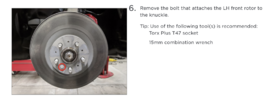Just tried fitting my ex Model 3 space saver wheel to my Model Y to see if I could reuse it on the Y.
However there is a small hex screw in the face of the wheel hub which prevents my spare sitting flush to the hub, as shown on the attached pic. The original Y wheels have a shaped back face that misses this hex screw but the space saver has a full face on the back.
Does anyone know what this hex screw is for? Can it be removed as a temporary measure? Can the hub be modified to take a countersunk screw?
I never tried fitting the space saver to my Model 3 so I'm not sure if that had this hex screw or not. If it has, I was sold a duff space saver that wouldn't have fitted if I had needed it.

However there is a small hex screw in the face of the wheel hub which prevents my spare sitting flush to the hub, as shown on the attached pic. The original Y wheels have a shaped back face that misses this hex screw but the space saver has a full face on the back.
Does anyone know what this hex screw is for? Can it be removed as a temporary measure? Can the hub be modified to take a countersunk screw?
I never tried fitting the space saver to my Model 3 so I'm not sure if that had this hex screw or not. If it has, I was sold a duff space saver that wouldn't have fitted if I had needed it.



